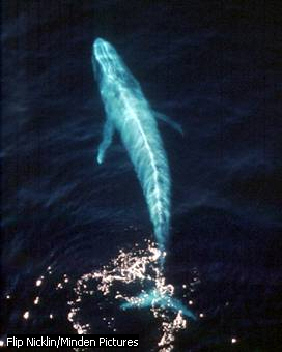HOME
ANIMALS
SEA LIFE
Blue Whales
 The
Blue Whale is not only the largest whale, but also the largest
creature ever to inhabit the earth. Blue whales are found in all
oceans of the world. Most populations migrate extensively, traveling
from the Tropics or near Tropics in winter to the edges of the pack
ice in the northern and southern hemispheres in summer. Blue whales
produce loud, low-frequency moans that can be heard in deep ocean
waters from more than 100 miles away. It is likely that they
communicate by means of these moans, enabling the members of a group
to remain in contact across a vast expanse of ocean.
The
Blue Whale is not only the largest whale, but also the largest
creature ever to inhabit the earth. Blue whales are found in all
oceans of the world. Most populations migrate extensively, traveling
from the Tropics or near Tropics in winter to the edges of the pack
ice in the northern and southern hemispheres in summer. Blue whales
produce loud, low-frequency moans that can be heard in deep ocean
waters from more than 100 miles away. It is likely that they
communicate by means of these moans, enabling the members of a group
to remain in contact across a vast expanse of ocean.
The loud moans
of blue whales may carry through deep waters to distances more than
100 miles away, allowing them to communicate across vast areas of
water. Hunted nearly to extinction in the first half of the 20th
century, blue whales are now protected, although they remain
endangered. Flip Nicklin/Minden Pictures
Blue whales may reach 100 feet in length and weight about 300,000
pounds, mature females are usually slightly longer than mature males.
A small dorsal fin is set far back on the body. The skin has a light-gray-and-white
mottled pattern, which appears light blue when the whale is just
below the surface of the water on a sunny day. The mottled pattern,
which is unique to each animal, has been used by researchers to
identify individual whales.
Blue whales feed by lunging openmouthed into dense groups of small
sea creatures such as krill or fish. As water and food rush into the
whale's mouth, more than 60 throat pleats expand so that the whale's
throat, or gular pouch, forms a huge bag that extends from the front
of the whale's snout to its navel. The whale then partially closes
its mouth, leaving a small gap, and forces water past 270 to 390
pairs of wide, black, fringed baleen plates that hang from the roof
of the mouth. The plates act as a sieve, catching food inside the
fringes. Blue whales often lunge through their prey side by side,
apparently using each other to block the escape of their prey.
Mature females may give birth once every two or three years. Mating
occurs during the summer season, and the gestation period lasts about
11 months. A single young is usually born the following spring; twins
are rare. The young nurse for seven or eight months, gaining as much
as 200 pounds per day.
Blue whales were heavily hunted for oil, baleen, meat, and other
products from the 1930s to the 1960s. This hunting nearly caused the
extinction of the species. They are now protected and may gradually
be returning in several areas of their range; since 1985, blue whales
feeding in Monterey Bay, California, have become a familiar sight in
late summer. The blue whale is classified as an endangered species.
During the summer, a blue whale can eat about 40 million krill a
day-about 7940 pounds of food. Blue whales can live up to 100 years.
A blue whale can spout water up to 30 feet high. A male is called
bull, a female is cow, a young whale is called calf and a group of
whales is a pod.
Contributed By: Bernd G. Wursig
"Blue Whale," Microsoft® Encarta®
Encyclopedia 99. © 1993-1998 Microsoft Corporation. All rights reserved.
 The
Blue Whale is not only the largest whale, but also the largest
creature ever to inhabit the earth. Blue whales are found in all
oceans of the world. Most populations migrate extensively, traveling
from the Tropics or near Tropics in winter to the edges of the pack
ice in the northern and southern hemispheres in summer. Blue whales
produce loud, low-frequency moans that can be heard in deep ocean
waters from more than 100 miles away. It is likely that they
communicate by means of these moans, enabling the members of a group
to remain in contact across a vast expanse of ocean.
The
Blue Whale is not only the largest whale, but also the largest
creature ever to inhabit the earth. Blue whales are found in all
oceans of the world. Most populations migrate extensively, traveling
from the Tropics or near Tropics in winter to the edges of the pack
ice in the northern and southern hemispheres in summer. Blue whales
produce loud, low-frequency moans that can be heard in deep ocean
waters from more than 100 miles away. It is likely that they
communicate by means of these moans, enabling the members of a group
to remain in contact across a vast expanse of ocean.